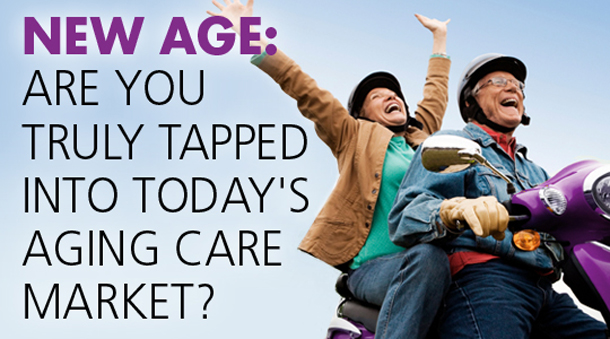
Home care marketing today is vastly different than it was even just a few years ago. Not only have marketing avenues changed – from the Yellow Pages and static print ads to dynamic websites and social media – the people have changed, too! And those people (your target market) aren’t your grandmother’s senior citizens.
While much of aging care marketing focuses on the children of the person who will receive care, it’s important not to forget that your company must also make its services appealing to a livelier, hipper, and more digitally savvy senior demographic. This means setting aside a few senior clichés and embracing the new age of aging care, and the new aging.
Bikes and Marathons Replacing Shawls and Canes
When the terms “elderly” or “senior citizen” are used, we often jump to several conclusions: the person is frail, slow-moving, her favorite hobby is knitting, he needs a cane to get around, etc. While these stereotypes are sometimes true of older adults, they are not necessarily the norm any longer. In fact, The Wall Street Journal recently reported that people age 50 and older are the fastest-growing demographic among marathon runners. The baby boomer generation has produced seniors who are dedicated to staying healthy and living active lives, and they want to support (and be supported by) companies who embrace that mentality. Marketing how your products and services can support an active lifestyle, even when health or mobility becomes an issue, will get you noticed in today’s market.
“Old” Isn’t Part of Their Vocabulary
No one likes to be called old, least of all older adults, and no one wants to use services marketed toward “old people.” Adjust the messaging of your marketing to be sensitive to these feelings. Be open and positive about your services, address how your company can be a solution for specific problems brought about by aging, but never assume anything and never talk down to your target market. And while a wholly non-offensive term for “senior citizen” has yet to be coined, be aware of the fact that few want to be called, or have their loved ones referred to as, “old” or “elderly.” There is also the question, “When does old start?” The age of 65 is certainly a lot younger than previously thought, and many aging adults do not need care until well after 85. So, be careful when thinking that an established age is the determinant for aging and frailty, when, in actuality, it is the frailty that makes someone old, not the age.
Solutions Are Needed
When it’s time to research aging care services, older adults and their families are looking for solutions to specific problems that have cropped up in their lives. When it comes to care in their golden years, no matter the age those years happen to occur, no one makes snap decisions, so be sure to market in a way that details just how your company can solve the problem, make life easier, assist in care, or whatever your service or product accomplishes.
Today’s senior citizens are changing the face of aging. Is your aging care business adjusting to suit their needs and lifestyles? Let corecubed’s home health care marketing experts help. Our team of knowledgeable professionals has decades of experience in developing engaging senior citizen advertising and marketing strategies that bring proven ROI to your home care business. Contact us at 800.370.6580, x1, to learn more.
